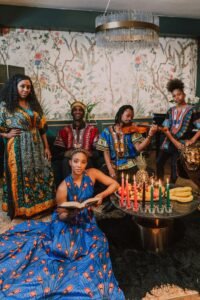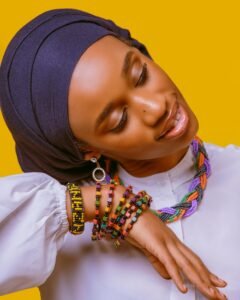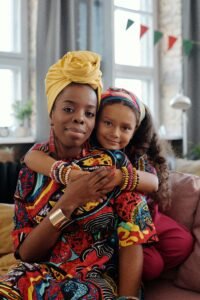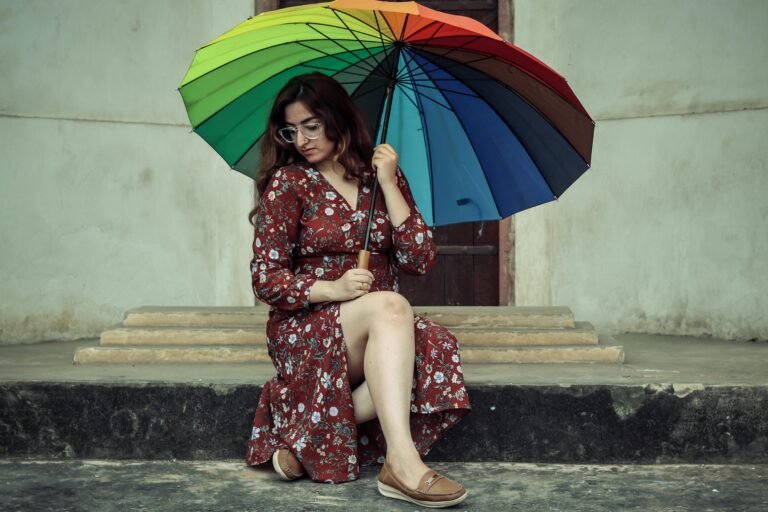Introduction to Modern African Fashion
Modern African fashion represents a vibrant confluence of tradition and innovation, where designers skillfully blend age-old fabrics and prints with contemporary Western styles. This unique fusion not only showcases the rich cultural heritage of the African continent but also highlights its dynamic nature. African designers are increasingly gaining global recognition for their ability to maintain a delicate balance between preserving traditional aesthetics and embracing modern trends.
At the heart of modern African fashion is the use of indigenous textiles such as Ankara, Kente, and Mudcloth. These fabrics, known for their bold colors and intricate patterns, serve as a canvas for creative expression. By incorporating these materials into modern silhouettes, designers are able to create pieces that are both culturally significant and fashion-forward. This approach allows them to honor their heritage while appealing to a global audience.
The significance of this fusion goes beyond mere aesthetics. It reflects a deeper narrative about the resilience and adaptability of African cultures. In an era of globalization, where cultural identities are constantly evolving, modern African fashion serves as a testament to the ability of these cultures to innovate without losing their essence. It embodies a sense of pride and continuity, showing that African traditions can coexist harmoniously with contemporary influences.
Furthermore, the global impact of modern African fashion is evident in the increasing presence of African designers on international runways and fashion weeks. Their work not only garners admiration but also challenges stereotypes and broadens the understanding of African culture. By merging the old with the new, these designers are redefining the global fashion landscape, making a powerful statement about the relevance and richness of African heritage.
As we delve deeper into the various facets of modern African fashion, it becomes clear that this movement is more than just a trend. It is a celebration of identity, creativity, and cultural evolution, offering a fresh perspective on what it means to stay connected to one’s roots in a rapidly changing world.
Historical Context of African Traditional Fabrics and Prints
African traditional fabrics and prints hold profound cultural significance, representing the rich tapestry of the continent’s diverse heritage. Among the most iconic materials are Ankara, Kente, and Mud Cloth, each with its unique history and symbolic meanings that have been preserved and celebrated through generations.
Ankara, also known as African wax print, is renowned for its vibrant colors and intricate patterns. This fabric, initially inspired by Indonesian batik, was introduced to West Africa by Dutch traders in the 19th century. Over time, Ankara became an integral part of African culture, symbolizing various social statuses, occasions, and communal identities. It is commonly used in ceremonies, including weddings and celebrations, highlighting its role in expressing cultural pride and unity.
Kente, originating from the Ashanti Kingdom in present-day Ghana, is another significant African fabric. Traditionally woven from silk and cotton, Kente cloth is characterized by its bright, multicolored patterns, each design bearing a specific meaning. Historically, Kente was reserved for royalty and special occasions, symbolizing wealth, high social standing, and spiritual power. Today, it remains a potent emblem of African heritage, worn during important cultural events and as a statement of identity and solidarity.
Mud Cloth, or Bogolanfini, hails from Mali and is deeply rooted in the Bambara people’s traditions. Created using hand-woven cotton dyed with fermented mud, Mud Cloth features distinctive geometric patterns. Each symbol and motif tells a story, often reflecting historical events, social status, or moral lessons. This fabric has been used in various ways, from clothing to household items, serving both functional and decorative purposes. Mud Cloth continues to be a medium through which African artisans convey their cultural narratives and artistic expression.
Understanding the historical context of these fabrics provides insight into their enduring significance in African culture. These textiles are not merely fashion statements but are imbued with historical and cultural narratives, making them powerful expressions of African identity and heritage.
The Evolution of African Fashion
African fashion has undergone a remarkable transformation, evolving from traditional attire to contemporary fashion statements that captivate global audiences. Historically, African garments were deeply rooted in cultural and social significance, with each piece often symbolizing identity, status, and heritage. Traditional fabrics such as kente, ankara, and mudcloth were not just clothing materials but carried profound meanings and were utilized in ceremonies, rituals, and daily life.
The transition from traditional to modern African fashion began in the mid-20th century, spurred by a desire among African designers to blend cultural heritage with contemporary aesthetics. This shift was marked by a fusion of traditional fabrics and patterns with modern silhouettes and tailoring techniques. The result was a unique style that maintained the essence of African culture while appealing to broader fashion sensibilities.
In recent decades, African fashion has continued to evolve, driven by the ingenuity and creativity of designers who seamlessly merge the old with the new. Designers like Ozwald Boateng, Duro Olowu, and Maki Oh have gained international acclaim for their ability to integrate traditional African elements into modern fashion. Their work embodies a rich tapestry of cultural heritage, innovation, and contemporary appeal, allowing African fashion to transcend borders and resonate with diverse audiences.
The global recognition of African fashion is also reflected in the increasing presence of African designers at major fashion weeks and the growing popularity of African-inspired designs among international fashion houses. This global impact underscores the adaptability of African fashion, as it continues to inspire and influence the broader fashion industry. The evolution of African fashion is a testament to the dynamic interplay between tradition and modernity, showcasing the ability of African designers to honor their heritage while pushing the boundaries of contemporary fashion.
Global Recognition and Impact of African Fashion
African fashion has seen a remarkable rise on the global stage, captivating international audiences and making significant strides in the fashion industry. This ascendancy is particularly evident in the presence of African designs at prestigious international fashion shows and cultural festivals. Designers from the continent are increasingly being invited to showcase their collections at major events such as Paris Fashion Week, New York Fashion Week, and Milan Fashion Week. These platforms have become conduits for African traditional dress to gain admiration and recognition worldwide.
One of the key elements driving this global recognition is the unique blend of traditional African textiles, patterns, and techniques with contemporary fashion aesthetics. This fusion not only preserves the rich cultural heritage of Africa but also reinvents it in a way that resonates with diverse audiences. Vibrant colors, bold prints, and intricate beadwork are just a few of the distinctive features that have captivated fashion enthusiasts and critics alike. As a result, African garments have transcended beyond mere clothing to become powerful symbols of identity and pride.
Moreover, cultural festivals around the world have played a crucial role in celebrating and popularizing African fashion. Events like the Africa Fashion Week in London and the Dakar Fashion Week in Senegal have provided platforms for designers to present their work to a global audience. These festivals not only showcase the creativity and craftsmanship inherent in African fashion but also foster a greater understanding and appreciation of African culture and traditions.
The impact of African fashion extends beyond aesthetics; it is a movement that promotes cultural exchange, diversity, and inclusivity. As more international celebrities and influencers don African-inspired attire, the visibility and desirability of these garments continue to grow. This trend signifies a broader acceptance and admiration of African culture, inspiring pride among people of African descent and educating others about the richness of African traditions.
In essence, the global recognition of African fashion underscores its significance as a cultural asset and a source of identity. As African designers continue to make their mark on the global fashion scene, they not only celebrate their heritage through style but also contribute to a more diverse and inclusive fashion industry.
The Cultural Significance of Styling Like an African
Modern African fashion transcends mere aesthetics, serving as a profound expression of cultural heritage, identity, and the celebration of a rich, diverse history. Styling like an African involves more than simply donning vibrant fabrics or intricate patterns; it is a deliberate act of honoring traditions, embracing diversity, and showcasing the beauty of African cultures to the world.
Throughout the African continent, fashion is a powerful medium for storytelling. Traditional garments, such as the Nigerian agbada, the Ghanaian kente cloth, or the Maasai shuka, each hold unique cultural narratives and historical significance. These pieces are often crafted with intricate detail and symbolic colors that convey messages about the wearer’s community, status, and personal journey. By incorporating these elements into modern fashion, designers and individuals alike pay homage to their roots and keep these rich traditions alive.
Styling like an african-celebrating heritage and diversity
Embrace African Prints: Incorporate fabrics like Ankara, Kente, or Mud Cloth into your wardrobe. These bold prints can be used for dresses, skirts, blouses, or headwraps.
Colourful Palette: Style with Earthy tones, vibrant reds, yellows, and greens. Mix and match colours to create eye-catching outfits.

Symbolic Jewellery: Adorn yourself with jewellery that carries meaning. Wear the jewellery with Adinkra symbols or other African motifs.

Flowy Silhouettes: Select flowy Kente Cloth wide-leg pants, maxi dresses, or kaftans. These relaxed silhouettes evoke the spirit of African fashion.

Kaftans: Flowy, ankle-length garments that can be worn as dresses or over pants.

Ankara Dresses: Ankara fabrics come in various styles—maxi dresses, peplum tops, or jumpsuits.
Kente Cloth: Incorporate Kente patterns into your outfits. These colorful woven fabrics are rich in symbolism

African Hairstyles:



The Afro: Embrace your natural curls by wearing a classic Afro hairstyle. Keep your hair moisturized and use a wide-tooth comb for volume.
Braids and Twists: Try box braids, Senegalese twists, or cornrows. These protective styles are not only fashionable but also practical.
Headwraps and Turbans: Wrap a colourful headscarf or turban around your hair. They’re both stylish and practical.
By thoughtfully incorporating African prints into your wardrobe, you can celebrate African heritage while making a bold fashion statement. Embrace the diversity and richness of Afrocentric fashion and let your style reflect the beauty of these timeless fabrics.
Spotlight on Influential African Designers
Africa’s rich and diverse cultural heritage is eloquently mirrored through its vibrant fashion scene. Among the many influential figures propelling African fashion onto the global stage are designers whose creativity and dedication have left an indelible mark. These designers not only celebrate African heritage but also innovate, blending traditional elements with contemporary aesthetics to create unique, trailblazing styles.
One such designer is Imane Ayissi, a Cameroonian fashion maven whose work seamlessly integrates traditional African textiles with haute couture techniques. Ayissi’s collections are renowned for their elegance and sophistication, often featuring luxurious fabrics such as raffia, silk, and cotton. His designs have graced the runways of Paris Fashion Week, symbolizing a bridge between African heritage and modern fashion.
Another pivotal figure is Lisa Folawiyo from Nigeria. Folawiyo is celebrated for her innovative use of Ankara, a traditional West African fabric, which she transforms with intricate embellishments and contemporary silhouettes. Her brand, Jewel by Lisa, has garnered international acclaim, with her pieces being worn by celebrities and featured in major fashion magazines. Through her work, Folawiyo not only preserves but also elevates African fashion on a global scale.
From South Africa, Thebe Magugu has emerged as a significant force in the fashion industry. Magugu’s designs are a testament to his deep cultural roots and forward-thinking approach. He often infuses his collections with narratives that reflect social and political themes, making his work not just fashion-forward but also thought-provoking. As the first African designer to win the prestigious LVMH Prize, Magugu’s influence extends far beyond the continent.
Lastly, Maxhosa by Laduma, led by Laduma Ngxokolo, stands out for its vibrant knitwear inspired by traditional Xhosa beadwork. Ngxokolo’s designs are a colorful celebration of his heritage, gaining international recognition for their bold patterns and cultural significance. Through Maxhosa, Ngxokolo offers a modern interpretation of African fashion, appealing to both local and global audiences.
These designers exemplify the dynamic spirit of African fashion, each contributing uniquely to its global impact. Their work not only preserves the essence of African heritage but also inspires and influences the broader fashion industry, making African fashion a significant and celebrated part of the global style narrative.
Embracing African Fashion: A Call to Action
African fashion is more than just a trend; it is a celebration of a rich heritage, vibrant culture, and unparalleled diversity. Embracing African fashion is an invitation to participate in a global movement that honors the creativity and craftsmanship of African designers. By incorporating African-inspired styles into your wardrobe, you contribute to a broader appreciation and recognition of the continent’s artistic contributions.
Supporting African designers is a significant step towards sustaining and promoting the unique narratives embedded in their creations. These designers often draw inspiration from traditional textiles, patterns, and techniques, infusing them with modern twists that resonate on a global scale. By choosing to wear African fashion, you are not only showcasing your appreciation for this art form but also empowering the artisans and designers who bring these masterpieces to life.
Furthermore, exploring African fashion allows you to experience the diversity and richness of the continent’s various cultures. From the bold prints of West African Ankara to the intricate beadwork of the Maasai, each piece tells a story and carries a piece of history. Fashion enthusiasts and casual wearers alike can find something that resonates with their personal style while contributing to the narrative of global inclusivity.
We encourage you to delve into the world of African fashion with curiosity and respect. Attend fashion shows, follow African designers on social media, shop from brands that prioritize ethical practices, and share your discoveries with others. By doing so, you help foster a global appreciation for African fashion and ensure that its heritage continues to thrive.
Embracing African fashion is more than just a sartorial choice; it is a statement of solidarity with a continent rich in creativity and innovation. Let us celebrate and support African fashion, recognizing it as a vital part of the global fashion landscape.


